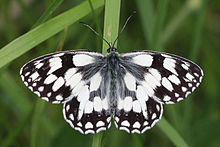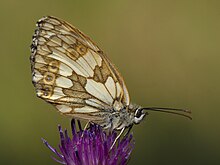Melanargia galathea
| Marbled white | |
|---|---|
 |
|
| Male Whitecross Green Wood, Oxfordshire, England |
|
 |
|
| Female underside Sindelfingen, Germany |
|
| Scientific classification | |
| Kingdom: | Animalia |
| Phylum: | Arthropoda |
| Class: | Insecta |
| Order: | Lepidoptera |
| Family: | Nymphalidae |
| Genus: | Melanargia |
| Species: | M. galathea |
| Binomial name | |
|
Melanargia galathea (Linnaeus, 1758) |
|
Melanargia galathea, the marbled white, is a butterfly in the family Nymphalidae. Found across most of Europe, southern Russia, Asia Minor and Iran. There is an isolated population in Japan. It is not found in Ireland, North Britain, Scandinavia (except Denmark) and Portugal or Spain. Despite its common name and appearance, this butterfly is one of the "browns", of the subfamily Satyrinae.
It is found in forest clearings and edges, meadows and steppe where it occurs up to 1,500-1,700 m above sea level. They are a common sight in unimproved grasslands across southern Britain, particularly on the South Downs, but also extending slightly further north to places such as the Dunstable Downs.
Like other members of its subfamily, the larvae feed on various grasses. These include Phleum (P. pratense), Poa (P. annua, P. trivalis), Festuca rubra, Bromus erectus, Dactylis, Brachypodium pinnatum and Agrostis capillaris. It is thought that red fescue (Festuca rubra) is essential in their diet.
Eggs are laid on the wing, or from brief perches on grass stems, and are just sprinkled among the grass stems. Upon hatching, the larvae immediately enter hibernation and only feed the following spring when the fresh growth occurs. They are a lime-green colour, with a dark green line running down the middle of their back. Pupation takes place at ground level in a loose cocoon. Adults emerge in July, and, on a good site, in warm, sunny weather, thousands can be seen gently fluttering amongst the grass heads.
The Iberian marbled white (Melanargia lachesis) replaces M. galathea in Spain and southern France.
The late twentieth century saw an expansion of its range in the UK.
...
Wikipedia
